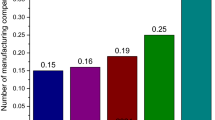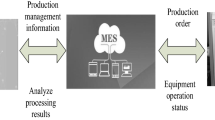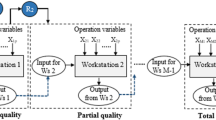Abstract
Product quality is the lifeblood of manufacturing enterprises. Under the background of intelligent manufacture, quality prediction is affected by lots of intricate elements. Furthermore, the customization level of products is one of the important factors which can support the enterprises in the increasingly fierce competition. Therefore, the high customization level means that it is impossible to collect a large quantity of quality data because of multi variety and small batch production mode. This paper proposes the principle and the framework of quality prediction in intelligent manufacturing. The framework adopts the theory of combinational prediction because it is more stable, more reliable and more accurate than single prediction model. The research of this paper will supply a new prediction method for the manufacturers and improve the accuracy of quality prediction and reduces the production risk.
Access provided by CONRICYT-eBooks. Download conference paper PDF
Similar content being viewed by others
Keywords
- Single prediction model selection
- Combinational prediction model
- TOPSIS
- Support vector regression
- Quality prediction
1 Introduction
Accurate quality prediction not only allows the manufacturing enterprises to under-stand the quality of products in advance, but also allows them to be well-prepared deal with the potential risks. In most cases, the enterprises select a variety of single prediction models to predict the quality based on different assumptions. According to the results of the hypothesis testing, they select the best single prediction model from all of the models. Because each single prediction model explains and analyzes the historical data from different angles, only part of the information are extracted from the historical data by each single prediction model. Thus, the prediction accuracy is affected. Obviously, this prediction process is not suitable in the rapidly changing manufacture industry [4].
Different single prediction models have their own advantages and disadvantages. Each model contains different information of historical data, which are interrelated and complementary to each other. Therefore, it will be more scientific if we combine the results of several single prediction models appropriately to make full use of the useful information contained in each single prediction model. This is the main concept of the combinational prediction, which can improve the precision and reduce the risk of prediction [1, 2].
The idea of combinatorial prediction proposed by Bates and Granger [3] in 1969 has received extensive attentions from scholars. In recent years, the theory of combinatorial prediction has been widely used in various fields, such as market demand, grain yield, meteorological prediction, power load and exchange rate. Several different single prediction models predict the same problem, and then the combinatorial prediction model will combine the predicted value of each single model. The key of combinatorial prediction is to utilize comprehensively the information of each single model, and to improve the prediction accuracy as much as possible [7].
However, while the theory of combinatorial prediction is booming, it is confronted with two major problems in the practical application.
-
1.
Among multiple single prediction models, which models can be selected as the in-put of the combinational prediction model?
-
2.
With the development of manufacture industry, the product quality is influenced by the more and more complicated external and internal factors. Which combinational prediction model can not only adapt to the complex environment, but also can predict more accurately and improve the generalization ability?
Under this background, we have carried on the research and the discussion to the above questions. Based on the previous researches, this paper proposes the framework of quality prediction, which integrates the selection arithmetic of single prediction model and combinational prediction model, which is especially suitable for the production mode of multi variety and small batch.
2 The Framework of Combinational Prediction Model in Intelligent Manufacturing
In this section, we will analyze the characteristics of intelligent manufacture firstly. According to the characteristics, we propose a framework of combinational prediction to predict the product quality in intelligent manufacturing.
2.1 The Characteristics of Intelligent Manufacturing
With the development of manufacturing technology, enterprises change from extensive mode of unitary-breed, huge-batch, rigid production to multi-varieties and small batch customized production, which has become the main production mode in intelligent manufacturing.
In the mode of multi-varieties and small batch customized production, the products have strong special purpose, the production processes are complex, parameters are diversified, the processing methods are not uniform, the environmental conditions of production are changeable and uncertain, production planning and control are cumbersome, the supervision is difficult to implement and the production management is dynamic [8]. The above characteristics will increase enterprise inventory and production cost and reduce the quality of the products.
Based on the above analysis, the principle of TOPSIS (Technique for Order Preference by Similarity to an Ideal Solution) method is proposed to serve as the selection model of single prediction models, which can evaluate the single prediction models synthetically. Furthermore, support vector machine Support vector regression machine is a small sample learning method [6]. It has good generalization ability even in the case of a small number of training samples. Especially, it is very effective to deal with non-linear regression problem. Considering the intelligent manufacturing is multivarieties and small batch customized production, we think support vector regression machine is suitable for quality prediction.
2.2 The Selection of Single Prediction Model
TOPSIS method is a sorting method of approximating the ideal solution, which is proposed by C. L. Hwang and K. Yoon [5]. The basic concept is to establish the initial decision matrix and the evaluation index system, and then based on the normalized initial matrix, a virtual ideal solution and a virtual negative solution are constructed. The ideal solution is a virtual solution composed of the optimal values of each evaluation index, and the negative solution is composed of the worst values of each evaluation index. The vertical distance between the evaluation objects (the optional single prediction models) and the ideal solution and the negative solution can be calculated. If an evaluation object is not only close to the ideal solution but also far away from the negative solution, this evaluation object has good performance. The algorithm is easy to apply and can evaluate the pros and cons of each single prediction model systematically and comprehensively. The specific process (Fig. 1) is as follows.
2.3 The Framework of Support Vector Regression Combinational Prediction Model
At present, there is no unique and universally accepted method and criterion about how to construct non-linear combinational prediction model. Several models are popular, such as polynomial function, nonlinear programming model and neural network. However, only when the size of the training samples is large, the effectiveness of these algorithms can be presented, which doesn’t adapt to the multi-varieties and small batch customized production mode in intelligent manufacturing.
After the research on the support vector regression machine, we put forward the framework of the combinational prediction model based on support vector regression machine, and divide the modeling process into four stages.
The first two stages are related to the selection of the single prediction models, and the last two stages construct a nonlinear combinational prediction model for the single prediction models selected in the first two stages by using the support vector regression. This proposed framework solves the problem of the single prediction model selection. It selects several single prediction models which has good performances in each evaluation index, and lays a solid foundation for the successful implementation of the combinational prediction. And particularly in the complex intelligent production environment, the support vector regression model can be used to self-learn the sample data effectively, and it has strong generalization ability, especially for the non-linear prediction with small sample. The framework is presented in Fig. 2.
The first stage is the pre-processing phase. At first, it is necessary to determine the prediction object and collect the historical data. According to the characteristics of the prediction object, we can select several single prediction models which satisfy the trend of the prediction object and determine the parameters of each single prediction model. The predictive value of each single prediction model is obtained based on the historical data.
The second stage is the single prediction model selection. After obtaining the prediction values of single models, we can constructs the evaluation index system and calculate the index values of each single prediction model. Then, the single prediction models are selected by using the TOPSIS method. According to the actual demand and the evaluation index system, the single prediction models which have good performances are chosen as the inputs of the combinational prediction model.
The third stage is the data training phrase. The predictive value of each single model is divided into two groups: training sample and prediction sample. The training sample is the input vector of the combinational prediction model based on the support vector regression machine, and the corresponding actual observation values are used as the output of the combinational prediction model. Next step is to select the appropriate kernel function and use the cross verification method based on grid search to optimize the parameters. Finally, the optimal parameters are put into the support vector regression combinational prediction model. After the model is trained, a support vector regression model is obtained.
The fourth stage is the prediction and evaluation phase. We can predict the pre-diction samples using the support vector regression combinational prediction model which is generated in the third stage. After obtaining the combinational predictive value, we can compare it with the actual observation value to evaluate the model performance.
3 Conclusion
In this paper, we focus on the quality prediction in intelligent manufacturing. TOPSIS method is proposed to select the single prediction model. It sets up a comprehensive scientific evaluation system to evaluate the performance of single prediction models from many aspects. Based on the statistical learning theory, a framework of the combinational prediction model based on support vector regression machine is proposed, which has good generalization and robustness. This framework can transform the low dimension nonlinear space into high-dimensional linear space, which overcomes the phenomenon of “over learning” and “dimensionality disaster”. It is very suitable for multi-varieties and small batch customized production mode in intelligent manufacturing.
References
Bates JM, Granger CWJ (1969) The combination of forecasts. Oper Res Q 20(4):451–468
Chen H (2008) The validity principle and application of combinational prediction. Science Press, Beijing
Diebold XF (2003) Element of forecasting. South-Western, Div of Thomson Learning
Elliott G, Granger CWJ, Timmermann AG (2006) Handbook of economic forecasting. Elsevier, Amsterdam
Vapnik VN (1995) The nature of statistical learning theory. Springer, Berlin
Wang J (2012) The research and application on several combinational prediction models. Ningxia University, China
Zhou Y (2009) The research on the TOPSIS method in multi-attribute decision-making. Wuhan University of Technology, China
Zheng WW, Liang JJ (2007) Research on the quality integration control of multi-varieties and small volume production process. Mach Des Manufact Eng 36(7):19–21
Acknowledgements
This work is supported by the foundation of Shanghai Polytechnic University (Grant No. EGD17XQD12).
Author information
Authors and Affiliations
Corresponding author
Editor information
Editors and Affiliations
Rights and permissions
Copyright information
© 2018 Springer Nature Singapore Pte Ltd.
About this paper
Cite this paper
Ji, M. (2018). Research on the Framework of Quality Prediction in Intelligent Manufacturing. In: Wang, K., Wang, Y., Strandhagen, J., Yu, T. (eds) Advanced Manufacturing and Automation VII. IWAMA 2017. Lecture Notes in Electrical Engineering, vol 451. Springer, Singapore. https://doi.org/10.1007/978-981-10-5768-7_60
Download citation
DOI: https://doi.org/10.1007/978-981-10-5768-7_60
Published:
Publisher Name: Springer, Singapore
Print ISBN: 978-981-10-5767-0
Online ISBN: 978-981-10-5768-7
eBook Packages: EngineeringEngineering (R0)






